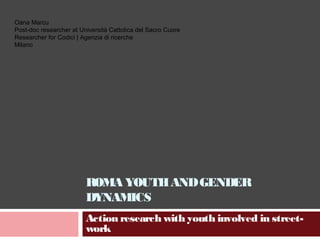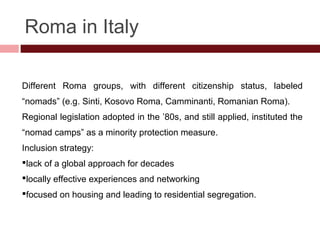Roma youth and gender action research
- 1. Oana Marcu Post-doc researcher at UniversitĂ Cattolica del Sacro Cuore Researcher for Codici | Agenzia di ricerche Milano ROMA YOUTH AND GENDER DYNAMICS Action research with youth involved in street- work
- 2. Roma in Italy Different Roma groups, with different citizenship status, labeled “nomads” (e.g. Sinti, Kosovo Roma, Camminanti, Romanian Roma). Regional legislation adopted in the ’80s, and still applied, instituted the “nomad camps” as a minority protection measure. Inclusion strategy: lack of a global approach for decades locally effective experiences and networking focused on housing and leading to residential segregation.
- 3. Romanian Roma:  “Nomads”, “irregular migrants” and EU citizens at the same time.  Low levels of employment  Living conditions:  regular (authorized nomad camps)  irregular (“abusive” encampments, squats)  Street-work as a survival strategy for youth and families.
- 4.  May 2008 - the “Security Package” and the “Nomadic Emergency Plan” legislative acts replaced politics of care with politics of eviction and control for Roma.  Services access: fragmented between countries and between regions in Italy.  Social and health services access conditioned by the legal residence.
- 5. Objectives  To explore the dynamics of street work and more generally the migratory paths of young people and their families.  To promote participation, empowerment and social inclusion for Romanian Roma youth involved in street-based activities.  To disseminate active knowledge and awareness in order to build equal opportunities for Roma youth.  To support change and good practices construction in institutions and services.
- 6. CASH CASH: The project Was provided Italian, private funding by Fondazione Cariplo, aimed at Social Inclusion, Partners:
- 7. Cash Cash: the action-research (2007-2010) Multiple professional figures (researchers, social-workers, photographer, peer-educator, ethno- psychologist); Team of three members and a coordinator.
- 8. METHOD CONTEXTS AND ACTIONS TARGET STRATEGIES AND TOOLS TIME Milan, Rome, Ethnography Craiova Ethnography & Participation 22 months Interviewing (individual/group, biographical) Romanian Roma Photography & visual research Milan Biographical youth & families methods 6 biographies laboratory Peer-research 8-14 hours each Narratives Music Milan Peer research 3 ½ months Institutional ethnography & Milan, Craiova networking Medical & counseling Participation & shadowing centers Mediation Juvenile justice and Knowledge co- Exchange of know how Milan protection institutions costruction Training & teaching 30 hours of Operators, volunteers, seminars Online blog training policemen, youth, Reporting & publishing citizens Public comunication Online
- 9. Ethnographic fieldwork Started in public places, by building rapport with young people, who introduced us to their homes and families
- 10. Biographical laboratory Collaborative life story writing, interviewing and photography explored youth’s representations of self.
- 11. Participated research with youth  A group of 7 young people (aged 16-20) conducted peer research, on a topic chosen by themselves: romantic relationships between Roma youth. Introduced  They reflected on gender and the role of a spotlight tradition, cultural change and on gender dynamics integenerational gaps.  Conducted peer interviewing, produced images and interpreted the results, with the support of project researchers.
- 12. Peer research (2) Group building
- 13. Peer research (3) Field research
- 14. Peer research (4) Strong Strong Our law: no Our law: no One One respect for respect for tribunals, but tribunals, but language language rules and rules and appointed appointed traditions traditions gipsy judges gipsy judges Focus Difference groups for between data men and analysis women Virginity: Feminine a valued attire Marriage principle rituals and practices
- 15. Peer research (5) Exploring different ways of storytelling
- 16. Intervention with services  Involved a wide array of professionals figures, working in various services (health, social services, NGOs, institutions).  4 months of collaborative ethnography with professionals juvenile justice institutions:  increasing services’ capacity in the social inquiry;  maintaining and mediating contact between social workers, young people, and families.
- 17. Group work  Active learning techniques such as conceptual maps, brainstorming, simulations and case studies.  Focus groups in trainings sessions in order to understand and reflect upon the most frequent and relevant situations that professionals met.
- 18. Data analysis  Qualitative (thematic) data analysis for interview transcrips and ethnographic field notes;  Metaphorical analysis for visual data  Produced a wealth of qualitative data, useful for understanding and interpreting the phenomena, but no quantitative data
- 19. Results  Insight into the gendered nature of street work  Understanding of transnational circuits and relationship between migration and informal economies  Increase of social workers’ knowledge and abilities in addressing vulnerabilities linked to the migration of Romanian Roma to Italy  Supported peer researchers in reflecting on their experience and producing knowledge about it.  Increased participants’ knowledge of available services and facilitated access to services
- 20. Limits  Conducted in an extremely harsh political moment, repressive measures taken towards irregular Roma (forced evictions) made it difficult to pursue all contacts.  Although efficient at an operational level, the action research did non have the expected impact at decisional levels  Required a lot of time and emotional resources for rapport to be built.
- 21. Future directions for Action Research  Working at higher decisional level (authorities administrations, policy-makers)  Although their participation is often difficult to obtain (e.g. SRAP, Roma-net)  Good definition of the population in question (avoiding the over-generalizing “Roma”)  Unambiguous criteria for population definition absolutely necessary in order to conduct quantitative research with large samples  Being sensitive to the different situation of various groups (e.g. immigrant vs. citizens Roma, irregular vs. regular migrants, etc)
- 22. Contacts If you want to contact us for details or collaborations, please do so! www.codiciricerche.it Oana.marcu@codiciricerche.it Photography: Luca Meola Luca.meola@codiciricerche.it






















